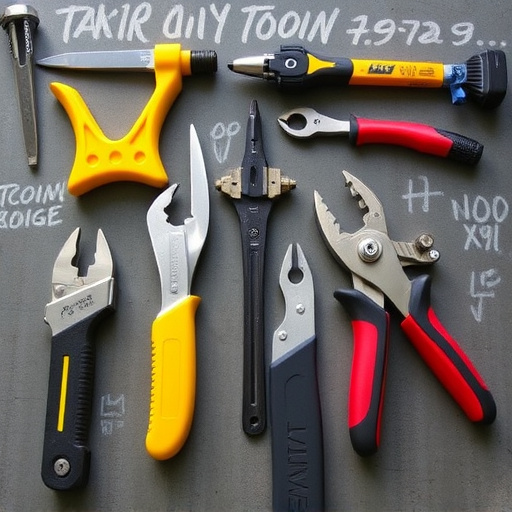Tesla Repair Network Shops: Certified Services for Your Car

Tesla repair network shops are certified mechanics and bodyshops that offer official services for el…….
In the rapidly evolving landscape of electric vehicle (EV) manufacturing, Tesla has emerged as a pioneer, reshaping the automotive industry with its cutting-edge technology and innovative business models. Central to this revolution is the concept of a robust Tesla repair network—a sophisticated system designed to ensure optimal vehicle performance, safety, and customer satisfaction. This article delves deep into the world of Tesla repair network shops, exploring their structure, global impact, technological innovations, and the challenges they face in an ever-changing market. By examining these aspects, we aim to provide valuable insights for industry stakeholders, enthusiasts, and anyone interested in the future of automotive maintenance.
A Tesla repair network shop is a specialized facility authorized by Tesla, Inc. to perform maintenance, repairs, and servicing on its electric vehicles (EVs). These shops are strategically located across various regions, ensuring accessibility for Tesla owners worldwide. The network comprises several key components:
Authorized Service Centers: These are the primary repair facilities, equipped with specialized tools, trained technicians, and genuine Tesla parts. They handle complex repairs, diagnostics, and routine maintenance.
Mobile Service Teams: For remote or less populated areas, Tesla deploys mobile service teams. These technicians visit customers’ locations, offering on-site repairs and services, ensuring convenience for owners who might struggle to travel to a service center.
Online Booking and Scheduling: Tesla’s digital platform allows owners to book appointments, track vehicle diagnostics, and receive personalized recommendations for maintenance tasks. This streamlined approach enhances customer experience and facilitates efficient scheduling for service centers.
The concept of a dedicated repair network evolved with Tesla’s rapid growth and the increasing complexity of its vehicle technology. As Tesla vehicles gained popularity, the need for specialized knowledge and parts became evident. The traditional model of dealer networks, common in the internal combustion engine (ICE) car industry, didn’t entirely cater to the unique requirements of EV maintenance.
Tesla’s repair network shops address several critical aspects:
Consistency in Service Quality: By controlling the service process, Tesla ensures that its vehicles receive consistent, high-quality care, maintaining safety standards and performance across all models.
Accessibility and Convenience: With a global reach, these shops make essential maintenance and repairs more accessible to owners, reducing the inconvenience often associated with traditional vehicle servicing.
Specialized Training: Tesla invests in training its technicians, ensuring they are adept at handling EV-specific issues, such as battery management and advanced electrical systems.
Parts Availability: The network ensures a steady supply of genuine Tesla parts, crucial for maintaining the vehicle’s performance and resale value.
Tesla’s repair network has expanded globally, reflecting the company’s ambitious international growth strategy. Key markets include North America, Europe, Asia-Pacific, and emerging regions like South America and Africa. Each region presents unique challenges and opportunities:
| Region | Market Size (2022) | Key Challenges | Growth Opportunities |
|---|---|---|---|
| North America | Largest market for EVs, with Tesla leading the charge. | Established infrastructure, stringent regulations. | Growing demand for advanced EV services, expansion into rural areas. |
| Europe | Rapidly growing, driven by government incentives and aggressive targets. | Harmonizing regulations across EU member states. | Increasing adoption of premium EVs, opportunities in urban centers. |
| Asia-Pacific | Largest market in terms of volume, diverse preferences. | Overcoming range of challenges, including cultural and regulatory barriers. | Emerging economies offering untapped potential, need for affordable EV options. |
Europe’s Homogeneity: In Europe, Tesla has focused on establishing a uniform network across countries with similar vehicle regulations, ensuring consistent service quality.
North America’s Urban-Rural Divide: The company addresses the vast distances and dispersed populations in North America by deploying mobile service teams and strategic placement of service centers in urban hubs.
Asian Market Dynamics: In Asia, Tesla tailors its network to local preferences for affordable EVs and diverse driving conditions, often involving partnerships with existing automotive service chains.
Tesla’s repair network shops are a significant part of the company’s overall economic strategy. The global expansion of this network involves substantial investments in real estate, infrastructure, and human resources. Key economic aspects include:
Franchise Business Model: Tesla follows a franchise model, allowing local entrepreneurs to operate as authorized service centers under the Tesla brand. This approach fosters local ownership while maintaining consistent standards.
Cost Structure: The network’s cost structure includes facility setup, equipment, inventory (parts), technician salaries, and marketing expenses. Tesla provides initial training and ongoing support to franchisees.
Revenue Streams: Revenue primarily stems from service and repair fees, parts sales, and additional services like vehicle diagnostics, detailing, and insurance.
The establishment of Tesla repair network shops has far-reaching economic implications for local communities:
Job Creation: These facilities create jobs for technicians, administrators, and support staff, contributing to employment rates in the region.
Economic Boost: The influx of customers and increased business activity can stimulate local economies, benefiting nearby businesses and service providers.
Real Estate Values: Strategic placement of service centers can enhance property values in surrounding areas, which is particularly noticeable in urban centers.
Tesla’s repair network shops have been at the forefront of embracing technological advancements in the EV sector:
Digital Diagnostics: Tesla’s advanced diagnostic tools enable technicians to perform thorough checks remotely, identify issues early on, and provide accurate quotes for repairs.
Battery Technology: Specialized training and access to cutting-edge battery technology allow technicians to handle complex EV battery replacements and repairs with precision.
Autonomous Repair Robots: Some service centers employ robotic arms for certain tasks, increasing efficiency and reducing the physical demands on technicians.
As technology evolves, Tesla’s repair network shops will continue to adapt:
Predictive Maintenance: AI-driven predictive analytics can anticipate maintenance needs based on vehicle data, reducing unexpected breakdowns and optimizing service schedules.
Remote Assistance: Advancements in remote assistance tools could allow technicians to guide owners through basic repairs or troubleshooting, extending the reach of expert support.
Cybersecurity Threats: With increased connectivity comes heightened cybersecurity risks. Protecting network infrastructure and customer data will be crucial as more services move online.
Tesla’s repair network shops operate within a complex web of policies and regulations, which vary significantly across jurisdictions:
Safety Standards: All service centers must adhere to local safety regulations regarding equipment, waste disposal, and handling hazardous materials (e.g., battery components).
Environmental Regulations: Strict environmental laws govern the disposal and recycling of EV batteries and other waste materials. Tesla’s network ensures compliance through proper waste management protocols.
Dealer Relations: In some regions, Tesla must navigate relationships with existing dealer networks, addressing concerns about competition and market share.
Government policies play a pivotal role in shaping the EV service industry:
Incentives and Subsidies: Many countries offer financial incentives for EV purchases, encouraging adoption. These policies can indirectly impact repair network shops by increasing vehicle sales.
Regulations on Emissions and Fuel Efficiency: Stringent regulations drive innovation in EV technology, creating a demand for specialized service providers equipped to handle advanced electrical systems.
Data Privacy Laws: As digital services expand, data privacy laws (e.g., GDPR) become critical considerations for Tesla’s network, ensuring customer data protection during online transactions and bookings.
Despite its many advantages, Tesla’s repair network faces several challenges:
Limited Network Coverage: In rural or less populated areas, the distance between service centers can be a significant barrier for owners, leading to delays in repairs.
High Initial Investment: Establishing a new service center requires substantial capital, which can deter potential franchisees or local entrepreneurs.
Technological Skill Gaps: As technology advances, ensuring that technicians possess the necessary skills and training becomes increasingly crucial, requiring ongoing investment in education and development.
To address these issues, Tesla and its partners have implemented various strategies:
Mobile Service Teams Expansion: Increasing the number of mobile service teams can improve accessibility, particularly in remote areas.
Franchisee Incentives: Offering financial incentives or reduced setup costs to franchisees can encourage more people to join the network, increasing coverage and diversity.
Digital Training Platforms: Developing online training platforms ensures that technicians worldwide can access the latest information and stay current with technological advancements.
In urban centers across Europe, Tesla has established a robust network of service centers integrated into existing automotive service ecosystems. In Berlin, Germany, for instance, Tesla partnered with a local garage that specialized in high-end vehicles. This collaboration ensured consistent service quality while leveraging the existing infrastructure and skilled labor force. The result was shorter wait times and convenient access to repairs, enhancing customer satisfaction.
In response to customer feedback and vast distances in North America, Tesla introduced its mobile service teams. In rural Texas, a customer struggling with a mechanical issue contacted Tesla’s online support. Within hours, a mobile technician arrived at the customer’s location, diagnosed the problem, and performed the necessary repairs on the spot. This case highlights Tesla’s commitment to providing efficient, convenient service regardless of geographical constraints.
The future landscape for Tesla repair network shops is promising, with several growth areas and trends to watch:
Expanding into New Markets: Tesla continues to explore opportunities in emerging economies, such as Southeast Asia and South America, where EV adoption is gaining momentum.
Over-the-Air Updates and Remote Service: As technology advances, Tesla may further leverage over-the-air (OTA) updates for software and firmware, potentially extending remote service capabilities.
Digital Transformation: Investing in digital infrastructure and online platforms will be crucial to enhance customer engagement, streamline scheduling, and facilitate remote diagnostics.
Sustainability Focus: As environmental concerns grow, Tesla’s network can emphasize eco-friendly practices, such as using renewable energy sources for operations and promoting sustainable waste management.
Partnerships and Collaborations: Strategic partnerships with local businesses or established automotive service chains can help expand coverage and accessibility in new regions.
Tesla’s repair network shops represent a significant milestone in the evolution of electric vehicle ownership, offering unparalleled convenience, expertise, and peace of mind to Tesla owners worldwide. This comprehensive overview highlights the network’s global reach, technological innovations, and the strategic considerations shaping its future. As the EV market continues to expand, Tesla’s commitment to a robust service infrastructure will be vital in fostering consumer confidence and driving sustainable transportation solutions.
Q: Are Tesla repair shops only available in major cities?
A: No, Tesla has expanded its network globally, including urban centers, suburban areas, and even some rural locations through mobile service teams.
Q: How do I know if a particular location offers mobile repairs?
A: Tesla’s website and mobile app provide detailed information about each service center’s capabilities. If mobile services are available in your area, you can book them through the online platform.
Q: Can I get genuine Tesla parts for my vehicle outside of authorized service centers?
A: While you might find aftermarket parts, Tesla encourages owners to use genuine parts from authorized service centers to ensure optimal performance and safety.
Q: How does Tesla ensure the quality of its repair network worldwide?
A: Through rigorous training programs, consistent global standards, and regular audits, Tesla maintains high-quality service across all its network locations.
Q: What happens if I have a complex issue with my EV that requires specialized knowledge?
A: For complex issues, Tesla’s network directs owners to authorized service centers where experienced technicians can diagnose and repair the problem using specialized equipment.

Tesla repair network shops are certified mechanics and bodyshops that offer official services for el…….

Tesla offers a global repair network with certified shops for Model S, 3, X, and Y vehicles, ensurin…….

Tesla repair network shops are vital for maintaining and servicing Tesla vehicles, offering speciali…….

Tesla repair network shops maintain exceptional quality standards with advanced facilities and skill…….

Tesla repair network shops play a vital role in maintaining the safety and efficiency of Tesla vehic…….

Tesla repair network shops provide global, authorized services for routine to complex vehicle repair…….